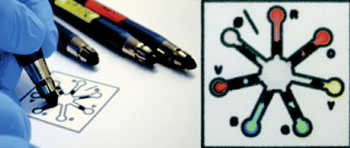Innovative Chemistry Set Applies Coloring-Book Approach to Perform Life-Saving Tests
By LabMedica International staff writers
Posted on 19 May 2015
Scientists have developed a set of “reagent pencils” for solvent-free deposition of reagents onto paper-based microfluidic devices that offers a new option for simple, customized point-of-care diagnostics, and other chemical testing applications.Posted on 19 May 2015
A doctor scribbling on a notepad may soon be not only for medical notes, but also for real-time chemical preparations for a rapid diagnostic test. Researchers from California Polytechnic State University (San Luis Obispo, CA, USA) have developed reagent pencils with chemicals formed into pencils to test reactions by simply drawing on specialized paper then adding water, upon which the reagents dissolve from the pencil matrix and become available to react with analytes in the sample.
The project began with the established technique of paper-based microfluidics that uses capillary action of paper to carefully mix together reagents. The established technique uses, for example, drops of two or more reagent solutions absorbed by a paper-based strip, spreading outward until they merge to form a mixture. In the new approach, the reagents are applied with reagent pencil instead of drops.
The pencils were prepared by pulverizing a mixture of graphite (as in normal pencils), test reagents, and polyethylene glycol, which helps keep the reagents dispersed (used for the same purpose in toothpaste). The mixture was compressed into pellets and mounted into mechanical pencil holders. The reaction-paper pad was prepared using a waxy ink to print small connected enclosures onto filter paper. The reagent pencils are used to color-in the areas within the enclosures. Upon adding water to the paper, the reagents dissolve and, confined by the waxy ink, are forced to diffuse towards one another.
The team demonstrated validity of a potential application by comparing to the colorimetric dropper test commonly used by diabetics to check their own blood glucose levels, which involves reacting a pinprick blood sample with a chemical solution. One pencil was constructed with a mixture of the enzymes horseradish peroxidase (HRP) and glucose oxidase (GOx). A second pencil contained ABTS. When combined in the presence of glucose these react to give a blue-colored product. The results were essentially the same accuracy and precision as the dropper method.
Set-up for this pad and pencil system requires only the skill of coloring within the lines, whereas the commonly used test requires significantly more training. And the reaction mix can be adjusted as necessary by simply applying more or less, without making up complex solutions.
Another advantage is that the reagents are extremely stable in the pencils – there was no sign of degradation after two months under ambient conditions, whereas in liquid form they usually degrade in days, limiting how and where the tests can be performed. The pencils kit is easily and stably transported.
In addition to diagnostic tests, the potential applications scope includes tests to monitor environmental pollutants and even new approaches to teaching chemistry and chemical testing in primary schools.
The study, by Mitchell HT et al, was published online April 8, 2015, in the journal Lab on a Chip.
Related Links:
California Polytechnic State University















